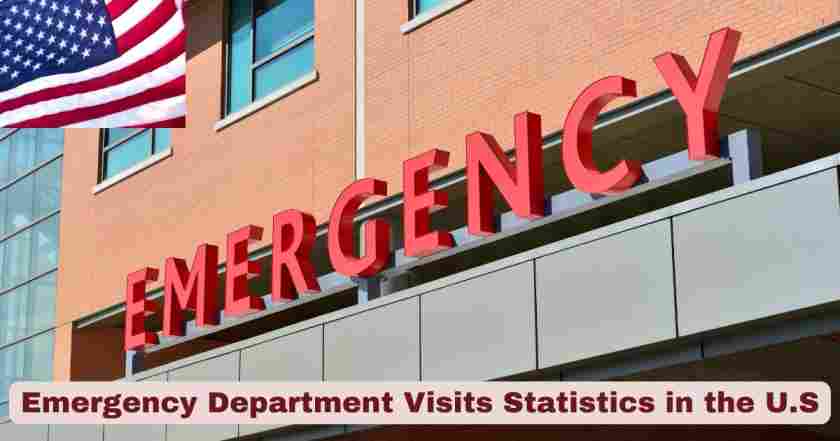Emergency Department Visits in the U.S. 2025
Emergency Department Visits in the U.S. remain a vital component of the nation’s healthcare delivery system, addressing both urgent and non-urgent medical needs for millions of Americans each year. In 2025, the U.S. recorded over 155 million emergency department (ED) visits, highlighting the growing reliance on EDs as a primary access point for healthcare—especially among vulnerable populations such as infants, the elderly, and the uninsured. These facilities continue to operate around the clock, providing critical care to patients regardless of their insurance status or ability to pay, and serving as the front line for trauma, infectious disease, and chronic illness complications.
The patterns of ED usage vary significantly based on age, race, gender, and insurance type, reflecting deep-rooted disparities in the broader healthcare system. Black Americans, Medicaid recipients, and seniors over 75 report some of the highest visit rates, underscoring the role of EDs in filling the gaps left by limited access to preventive and primary care services. Understanding who uses emergency departments—and why—is essential for improving healthcare infrastructure, reducing avoidable ED visits, and ensuring that critical resources are available for patients in genuine need of emergency care.
Key Emergency Department Facts in the U.S. 2025
| Interesting Emergency Department Facts | Details |
|---|---|
| Total Annual ED Visits | 155 million visits occurred in 2022 |
| Visit Rate per 100 People | 47 visits per 100 people nationally |
| Highest Age Group Usage | Infants under 1 year: 99 visits per 100 infants |
| Senior Population Usage | Adults 75+: 76 visits per 100 people |
| Racial Disparities | Black Americans: 91 visits per 100 people (highest rate) |
| Insurance Impact | Medicaid/CHIP patients: 99 visits per 100 people |
| Private Insurance | Private insurance: 21 visits per 100 people (lowest rate) |
| COVID-19 Related Visits | 4.8% of all ED visits had confirmed COVID-19 diagnosis |
| COVID-19 Testing/Screening | 22.8% of visits included COVID-19 testing or screening |
| Overall COVID-19 Mentions | 25.2% of all ED visits had any mention of COVID-19 |
There were 155 million emergency department (ED) visits across the United States, translating to an average of 47 visits per 100 people, underscoring the central role EDs play in the national healthcare system. Utilization varied significantly by age, with infants under 1 year exhibiting the highest usage rate at 99 visits per 100 infants, reflecting heightened parental concern and infant health vulnerability. The elderly population aged 75 and above followed closely behind, with 76 visits per 100 people, driven by age-related complications and chronic conditions. These high usage rates highlight the demand for responsive and specialized emergency care at both extremes of the age spectrum.
Notable disparities were also evident across racial, insurance, and pandemic-related factors. Black Americans had the highest ED usage among racial groups, with 91 visits per 100 people, while Medicaid and CHIP enrollees mirrored that figure at 99 visits per 100, indicating heavy reliance on emergency services due to potential gaps in routine or preventive care. In contrast, individuals with private insurance recorded the lowest usage at just 21 visits per 100 people, suggesting better access to alternative healthcare options. The impact of COVID-19 remained visible, with 4.8% of ED visits involving a confirmed COVID-19 diagnosis, 22.8% including COVID-19 testing or screening, and 25.2% of total visits containing any mention of COVID-19, reflecting the ongoing presence of the virus in emergency healthcare settings even as the acute phase of the pandemic subsided.
Emergency Department Visit Rates by Age Group in the U.S. 2025
| Age Group | Visits per 100 People | Key Characteristics |
|---|---|---|
| Under 1 Year | 99 | Highest utilization rate among all age groups |
| 1-4 Years | 41 | Moderate pediatric emergency usage |
| 5-14 Years | 43 | Stable school-age emergency visits |
| 15-24 Years | 46 | Young adult emergency utilization |
| 25-44 Years | 47 | Prime working-age emergency visits |
| 45-64 Years | 44 | Pre-senior adult emergency usage |
| 65-74 Years | 47 | Early senior emergency visits |
| 75+ Years | 76 | Second highest utilization rate |
Age-related emergency department utilization patterns reveal significant healthcare needs across different life stages. Infants under one year demonstrate the highest emergency department usage rates at 99 visits per 100 infants, reflecting the vulnerable nature of this population and parents’ heightened concern for infant health issues. This pattern indicates both the medical complexity of early childhood development and the tendency for new parents to seek immediate medical attention for concerning symptoms.
Adults aged 75 and older show the second-highest utilization rate at 76 visits per 100 people, demonstrating the increased medical complexity and acute care needs associated with advanced age. This population often presents with multiple chronic conditions, medication-related complications, and age-related health emergencies that require immediate medical intervention. The data suggests that both the youngest and oldest populations rely heavily on emergency departments for acute medical care, highlighting the importance of specialized emergency services for these vulnerable groups.
Emergency Department Visit Rates by Demographics in the U.S. 2025
| Demographic Category | Visits per 100 People | Significance |
|---|---|---|
| Black/African American | 91 | Highest racial/ethnic group utilization |
| White Non-Hispanic | 45 | Moderate utilization rate |
| Hispanic | 41 | Below-average emergency usage |
| Other Races | 21 | Lowest utilization rate |
| Female | 51 | Slightly higher than male usage |
| Male | 44 | Comparable to female usage patterns |
Demographic disparities in emergency department utilization highlight significant healthcare access inequalities within the American medical system. Black and African American patients utilize emergency departments at a rate of 91 visits per 100 people, more than double the rate of White non-Hispanic patients and over four times higher than patients from other racial categories. This substantial disparity reflects complex socioeconomic factors, including limited access to primary care, geographic healthcare deserts, and systemic barriers to preventive medical services.
The gender difference in emergency department utilization shows females accessing emergency services at 51 visits per 100 people compared to males at 44 visits per 100 people. This pattern may reflect differences in healthcare-seeking behavior, with women more likely to seek medical attention for both personal health concerns and family caregiving responsibilities. The demographic variations underscore the critical role emergency departments play in providing healthcare access to underserved communities while highlighting the need for comprehensive healthcare reform to address underlying access disparities.
Emergency Department Visit Rates by Insurance Coverage in the U.S. 2025
| Insurance Type | Visits per 100 People | Healthcare Access Impact |
|---|---|---|
| Medicaid/CHIP/State Programs | 99 | Highest emergency utilization rate |
| Medicare | 56 | Moderate senior emergency usage |
| Other Payment Sources | 42 | Worker’s compensation and other coverage |
| No Insurance (Uninsured) | 35 | Limited access affecting usage |
| Private Insurance | 21 | Lowest emergency utilization rate |
Insurance coverage dramatically influences emergency department utilization patterns, revealing significant healthcare access disparities across different payment mechanisms. Patients with Medicaid, CHIP, or other state-based programs demonstrate the highest emergency department usage at 99 visits per 100 people, nearly five times higher than privately insured patients. This pattern reflects the complex relationship between insurance coverage, primary care access, and emergency service utilization, with Medicaid patients often facing barriers to timely primary care appointments.
Private insurance holders show the lowest emergency department utilization rate at 21 visits per 100 people, suggesting better access to preventive care and primary care services that can address medical issues before they become emergencies. The substantial difference between Medicaid and private insurance utilization rates indicates that insurance type significantly impacts both healthcare access patterns and the likelihood of using emergency departments for non-emergency medical needs. This data emphasizes the importance of comprehensive healthcare coverage and improved primary care access in reducing inappropriate emergency department utilization while ensuring necessary emergency services remain available.
COVID-19 Impact on Emergency Department Visits in the U.S. 2025
| COVID-19 Related Visits | Percentage of Total ED Visits | Clinical Significance |
|---|---|---|
| Any COVID-19 Mention | 25.2% | Overall pandemic impact on emergency care |
| COVID-19 Testing/Screening | 22.8% | Diagnostic and preventive measures |
| Confirmed COVID-19 Cases | 4.8% | Actual positive diagnoses |
| Other COVID-19 Mentions | 2.8% | Exposure concerns and related issues |
| Non-COVID Emergency Visits | 74.8% | Traditional emergency medical care |
The COVID-19 pandemic significantly impacted emergency department operations and patient care patterns, with 25.2% of all emergency visits in 2022 having some mention of COVID-19. This substantial proportion demonstrates the ongoing influence of the pandemic on emergency medical services and patient health concerns. The majority of COVID-related emergency visits involved testing and screening at 22.8%, indicating that emergency departments served as important access points for COVID-19 diagnostic services during the pandemic period.
Confirmed COVID-19 cases represented 4.8% of all emergency department visits, showing that while COVID-19 testing was common, actual positive diagnoses constituted a smaller portion of total emergency care. This data reflects the cautious approach many patients took during the pandemic, seeking emergency department evaluation for potential COVID-19 symptoms or exposure concerns. The continued presence of COVID-19 in emergency department statistics demonstrates the lasting impact of the pandemic on healthcare utilization patterns and the adaptability of emergency medical services to address evolving public health challenges while maintaining essential emergency care services.
Historical Emergency Department Trends in the U.S. 2025
| Year | Total ED Visits (Millions) | Visit Rate per 100 People | Major Trends |
|---|---|---|---|
| 2021 | 139.8 | 42.7 | Post-pandemic recovery period |
| 2022 | 155.0 | 47.0 | Significant increase in utilization |
| 2020 | Reduced | Lower | Pandemic-related visit declines |
| 2019 | Higher | Pre-pandemic | Normal utilization patterns |
The historical trend analysis reveals significant fluctuations in emergency department utilization patterns, particularly highlighting the impact of the COVID-19 pandemic on healthcare access patterns. The substantial increase from 139.8 million visits in 2021 to 155.0 million visits in 2022 represents a notable recovery in emergency department utilization following pandemic-related disruptions. This 15.2 million visit increase suggests both pent-up demand for emergency services and the gradual return to normal healthcare-seeking behaviors.
The visit rate increase from 42.7 per 100 people in 2021 to 47.0 per 100 people in 2022 indicates a 10% rise in emergency department utilization. This trend reflects multiple factors including deferred medical care during the pandemic, increased comfort with seeking medical attention, and the ongoing need for emergency services as primary care access challenges persist. The data suggests that emergency departments continue to play a crucial role in healthcare delivery, particularly as healthcare systems adapt to post-pandemic realities and address accumulated healthcare needs in the population.
Emergency Department Resource Utilization in the U.S. 2025
| Utilization Metric | Value | Healthcare System Impact |
|---|---|---|
| Injury-Related Visits | 40.0 million | Significant trauma and injury care |
| Hospital Admissions from ED | 18.3 million | Critical care transitions |
| Critical Care Admissions | 2.8 million | Intensive care requirements |
| Visits Under 15 Minutes | 41.8% | Efficient emergency care delivery |
| Hospital Admission Rate | 13.1% | Serious condition identification |
| Hospital Transfers | 2.4% | Specialized care coordination |
Emergency department resource utilization data demonstrates the complex nature of emergency medical care and the significant role these facilities play in the broader healthcare system. Injury-related visits account for 40.0 million of total emergency department encounters, representing nearly one-quarter of all emergency visits and highlighting the substantial burden of trauma and injury care on emergency medical services. This volume underscores the importance of emergency departments in providing immediate care for accidents, violence-related injuries, and other traumatic events.
The hospital admission rate of 13.1% indicates that emergency departments successfully identify and treat serious medical conditions requiring inpatient care, with 18.3 million patients being admitted directly from emergency departments. Additionally, 2.8 million patients required admission to critical care units, demonstrating the life-saving capabilities of emergency medical services. The efficiency metric showing 41.8% of patients seen within 15 minutes indicates that emergency departments are effectively triaging and treating patients with varying levels of medical urgency while maintaining rapid response times for critical cases.
Disclaimer: The data research report we present here is based on information found from various sources. We are not liable for any financial loss, errors, or damages of any kind that may result from the use of the information herein. We acknowledge that though we try to report accurately, we cannot verify the absolute facts of everything that has been represented.







